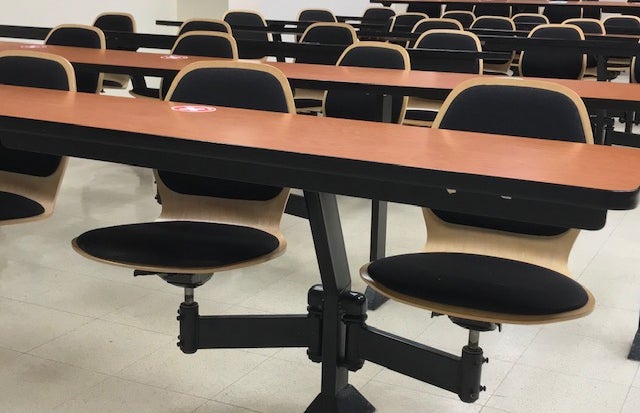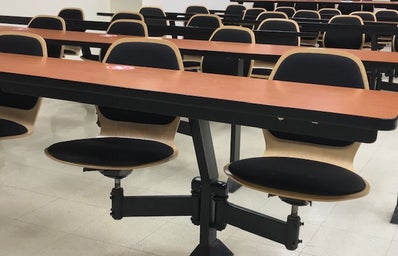Note: Certain participants are represented with an alias of their choosing.
Now, I am sure most Carleton students are familiar with the Swingy Chairs in question. It is possible that you may never have experienced sitting in these chairs (pictured above in the cover image) for one of your classes; however, you more than likely are destined to this fate at some point in your academic career.
These chairs are attached to the tables in pairs of two, with one seat on either side of each table post. They have a light-wash wooden base and black cushions. The seats are circular, and the backs are short to medium height. Because of the way they are attached to the table, the chairs twist around very easily.
Personally, I absolutely despise these chairs, which is why I should admit my bias up front. However, I was open to having my opinion shattered by some strong counterarguments. Thus, I decided to go out and interview some members of the treasured Carleton student population to put the tumultuous rumours to rest: at the end of the day, are these chairs good or bad? Do students have a preferred chair model? Do they have any swingy chair horror stories? Do they have any controversial opinions on the matter? Let’s find out.
“It’s just not that good…”
– Lexi
First, I asked around for some initial feelings on the Swingy Chairs. Describe the experience of sitting in this chair, I asked of participants. “It’s just not that good…” Lexi shared her first impression of sitting in the chair. Many other students similarly expressed somewhat unanimated but negative sentiments. “It’s definitely odd. Because it moves.” Jen told me.
One student, André, even expressed their confusion, after a semester of using these chairs: “I don’t know if I like it now or if I’m used to it now…”.
“I don’t know if I like it now or if I’m used to it now…”
–André
All the students I asked on the issue of Swingy Chairs seemed to have at least one thing to add to the discourse. Most people voiced their opinions in a peaceful and mild manner, open to hearing the opinions of those on the other side. Most agreed that everyone is entitled to their own opinion, but at the same time defended their own argument.
“The people who really do like [the Swingy Chairs] have not experienced the leg jiggling thing,” Lola insisted, referring to the way one can constantly feel the movements of other students in their row. Perhaps this is the point of the matter; each student has their own lived experience with these seating monstrosities. One person even revealed that they had seen multiple people falling off of the chairs in class — just horrible.
“Relax. It’s just a chair.”
– Charlie
Others preferred to provoke. “Relax. It’s just a chair,” one interviewee, Charlie, said. “If you’re that uncomfortable, don’t sit at all. Stand.” A take that is anti-discourse in itself? And yet participates in the discourse — interesting. Swingy Chair newcomer Lexi came in with an even hotter and more volatile take. “The person who made those chairs should be fired,” she said.
Now, let’s take a look at some math, in an effort to make this all appear more legitimate. I asked each participant to rate their feelings on the Swingy Chairs on a scale of 0 to 100. As you can see in the chart below, both the mean and median ratings were below 50, demonstrating once more that students did not feel exactly fond of this chair model in their classrooms.
| Mean Rating | 36.4 |
| Median Rating | 40 |
When asked if she had any suggestions for improvements in the Swingy Chair design, one student, Lola, responded, “They could just have normal chairs and desks?”
On ways to improve the design: “They could just have normal chairs and desks?”
– Lola
I also asked students if they had a preferred chair model to the Swingy Chair. Most interviewees did name a preferred chair model which they had used at some point on campus. These included the auditorium seats in the Azrieli Theatre, regular single chairs (provided they weren’t too heavy), and “the wheely ones that have nice padding.” Rarely did a student name Swingy Chairs as their model of choice.
All in all, from this small sample of students I interviewed, I have found that we have a mass controversy surrounding this particular chair model. They are not exactly popular — but they have some [somewhat indifferent] supporters nonetheless. Who knows where this discourse will take Carleton, students, next… formal debates, perhaps? Make sure to look out for any future updates.


